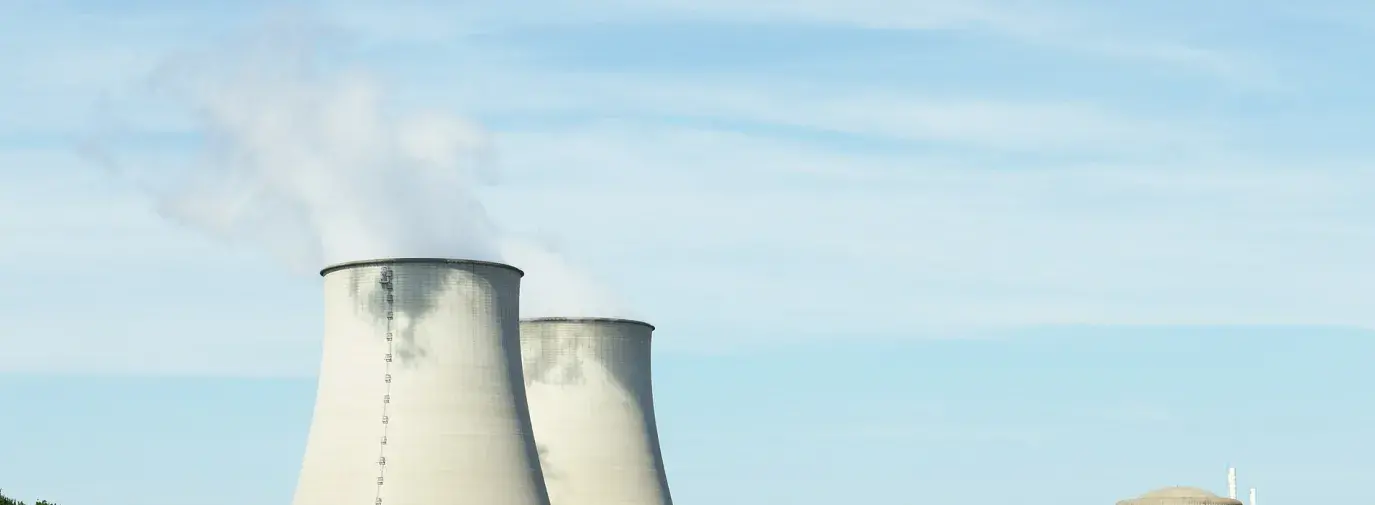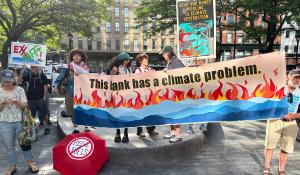
Green America is active in addressing the climate crisis by transitioning the US electricity mix away from its heavy emphasis on coal-fired and natural gas power. But all of that work will be wasted if we transition from fossil fuels to an equally dangerous source – nuclear energy. Nuclear fission power is not a climate solution. It may produce lower-carbon energy, but this energy comes with a great deal of risk.
Solar power, wind power, geothermal power, hybrid and electric cars, and aggressive energy efficiency are climate solutions that are safer, cheaper, faster, more secure, and less wasteful than nuclear power. Our country needs a massive influx of investment in these solutions if we are to avoid the worst consequences of climate change, enjoy energy security, jump-start our economy, create jobs, and work to lead the world in development of clean energy.
Currently there are 444 nuclear fission power plants in 30 countries worldwide, with another 63 plants potentially under construction. Those plants should not be built for the following reasons:
Ten Strikes Against Nuclear Energy
1. Nuclear waste:
The waste generated by nuclear reactors remains radioactive for tens to hundreds of thousands of years (1). Currently, there are no long-term storage solutions for radioactive waste, and most is stored in temporary, above-ground facilities. These facilities are running out of storage space, so the nuclear industry is turning to other types of storage that are more costly and potentially less safe (2).
2. Nuclear proliferation:
There is great concern that the development of nuclear energy programs increases the likelihood of proliferation of nuclear weapons. As nuclear fuel and technologies become globally available, the risk of these falling into the wrong hands is increasingly present. To avoid weapons proliferation, it is important that countries with high levels of corruption and instability be discouraged from creating nuclear programs, and the US should be a leader in nonproliferation by not pushing for more nuclear power at home (3).
3. National security
Nuclear power plants are a potential target for terrorist operations. An attack could cause major explosions, putting population centers at risk, as well as ejecting dangerous radioactive material into the atmosphere and surrounding region. Nuclear research facilities, uranium enrichment plants, and uranium mines are also potentially at risk for attacks that could cause widespread contamination with radioactive material (9).
4. Accidents
In addition to the risks posed by terrorist attacks, human error and natural disasters can lead to dangerous and costly accidents. The 1986 Chernobyl disaster in Ukraine led to the deaths of 30 employees in the initial explosion and has has had a variety of negative health effects on thousands across Russia and Eastern Europe. A massive tsunami bypassed the safety mechanisms of several power plants in 2011, causing three nuclear meltdowns at a power plant in Fukushima, Japan, resulting in the release of radioactive materials into the surrounding area. In both disasters, hundreds of thousands were relocated, millions of dollars spent, and the radiation-related deaths are being evaluated to this day. Cancer rates among populations living in proximity to Chernobyl and Fukushima, especially among children, rose significantly in the years after the accidents (4)(5).
5. Cancer risk
In addition to the significant risk of cancer associated with fallout from nuclear disasters, studies also show increased risk for those who reside near a nuclear power plant, especially for childhood cancers such as leukemia (6)(7)(8). Workers in the nuclear industry are also exposed to higher than normal levels of radiation, and as a result are at a higher risk of death from cancer (10).
6. Energy production
The 444 nuclear power plants currently in existence provide about 11% of the world’s energy (11). Studies show that in order to meet current and future energy needs, the nuclear sector would have to scale up to around 14,500 plants. Uranium, the fuel for nuclear reactors, is energy-intensive to mine, and deposits discovered in the future are likely to be harder to get to to. As a result, much of the net energy created would be offset by the energy input required to build and decommission plants and to mine and process uranium ore. The same is true for any reduction in greenhouse gas emissions brought about by switching from coal to nuclear (12).
7. Not enough sites
Scaling up to 14,500 nuclear plants isn’t possible simply due to the limitation of feasible sites. Nuclear plants need to be located near a source of water for cooling, and there aren’t enough locations in the world that are safe from droughts, flooding, hurricanes, earthquakes, or other potential disasters that could trigger a nuclear accident. The increase in extreme weather events predicted by climate models only compounds this risk.
8. Cost
Unlike renewables, which are now the cheapest energy sources, nuclear costs are on the rise, and many plants are being shut down or in danger of being shut down for economic reasons. Initial capital costs, fuel, and maintenance costs are much higher for nuclear plants than wind and solar, and nuclear projects tend to suffer cost overruns and construction delays. The price of renewable energy has fallen significantly over the past decade, and it projected to continue to fall (14).
9. Competition with renewables
Investment in nuclear plants, security, mining infrastructure, etc. draws funding away from investment in cleaner sources such as wind, solar, and geothermal. Financing for renewable energy is already scarce, and increasing nuclear capacity will only add to the competition for funding.
10. Energy dependence of poor countries
Going down the nuclear route would mean that poor countries, that don't have the financial resources to invest in and develop nuclear power, would become reliant on rich, technologically advanced nations. Alternatively, poor nations without experience in the building and maintaining of nuclear plants may decide to build them anyway. Countries with a history of nuclear power use have learned the importance of regulation, oversight, and investment in safety when it comes to nuclear. Dr. Peter Bradford of Vermont Law, a former member of the US Nuclear Regulatory Commission, writes, "A world more reliant on nuclear power would involve many plants in countries that have little experience with nuclear energy, no regulatory background in the field and some questionable records on quality control, safety and corruption." (15). The U.S. should lead by example and encourage poor countries to invest in safe energy technology.
Please also see the piece Nuclear Energy is not a Climate Solution
(1) Bruno, J., and R. C. Ewing. "Spent Nuclear Fuel." Elements 2.6 (2006): 343-49
(2) United States Nuclear Regulatory Commission. “Dry Cask Storage”. USNRC (2016)
(3) Miller, Steven E., and Scott D. Sagan. "Nuclear Power without Nuclear Proliferation?" Daedalus 138.4 (2009): 7-18
(4) Tsuda, Toshihide, Akiko Tokinobu, Eiji Yamamoto, and Etsuji Suzuki. "Thyroid Cancer Detection by Ultrasound Among Residents Ages 18 Years and Younger in Fukushima, Japan." Epidemiology (2016): 316-22.
(5) Astakhova, Larisa N., Lynn R. Anspaugh, Gilbert W. Beebe, André Bouville, Vladimir V. Drozdovitch, Vera Garber, Yuri I. Gavrilin, Valeri T. Khrouch, Arthur V. Kuvshinnikov, Yuri N. Kuzmenkov, Victor P. Minenko, Konstantin V. Moschik, Alexander S. Nalivko, Jacob Robbins, Elena V. Shemiakina, Sergei Shinkarev, Svetlana I. Tochitskaya, Myron A. Waclawiw, and Andre Bouville. "Chernobyl-Related Thyroid Cancer in Children of Belarus: A Case-Control Study." Radiation Research 150.3 (1998): 349
(6) Schmitz-Feuerhake I, Dannheim B, Heimers A, et al. Leukemia in the proximity of a boiling-water nuclear reactor: Evidence of population exposure by chromosome studies and environmental radioactivity. Environmental Health Perspectives 105 (1997): 1499-1504
(7) Spix C, Schmiedel S, Kaatsch P, Schulze-Rath R, Blettner M. "Case–control study on childhood cancer in the vicinity of nuclear power plants in Germany 1980–2003." European Journal of Cancer 44.2 (2008): 275–284
(8) Baker PJ, Hoel DG. "Meta-analysis of standardized incidence and mortality rates of childhood leukemia in proximity to nuclear facilities." European Journal of Cancer Care 16.4 (2007):355–363
(9) Ferguson, Charles D., and Frank A. Settle. "The Future of Nuclear Power in the United States." Federation of American Scientists (2012)
(10) Richardson, DB, Elisabeth Cardis, Robert Daniels, Michael Gillies, Jacqueline A O’Hagan, Ghassan B Hamra, Richard Haylock, Dominique Laurier, Klervi Leuraud, Monika Moissonnier, Mary K Schubauer-Berigan, Isabelle Thierry-Chef, Ausrele Kesminiene. "Risk of Cancer from Occupational Exposure to Ionising Radiation: Retrospective Cohort Study of Workers in France, the United Kingdom, and the United States" BMJ (2015)
(11) "World Statistics." nei.org. Nuclear Energy Institute.,Web. 04 Oct. 2016.
(12) Pearce, Joshua M. "Thermodynamic Limitations to Nuclear Energy Deployment as a Greenhouse Gas Mitigation Technology." International Journal of Nuclear Governance, Economy and Ecology 2.1 (2008): 113.
(13) "World Nuclear Industry Status Report 2014." World Nuclear Industry Status Report. World Nuclear Industry, July 2014. Web. 4 Oct. 2016.
(14) "Lazard's Levelized Cost of Energy Analysis - Version 9.0." Lazard.com. Lazard. 2015.
(15) Lynas, Mark, and Peter Bradford. "Should the World Increase Its Reliance on Nuclear Energy?" The Wall Street Journal. Dow Jones & Company, 08 Oct. 2012. Web. 10 Jan. 2017.






